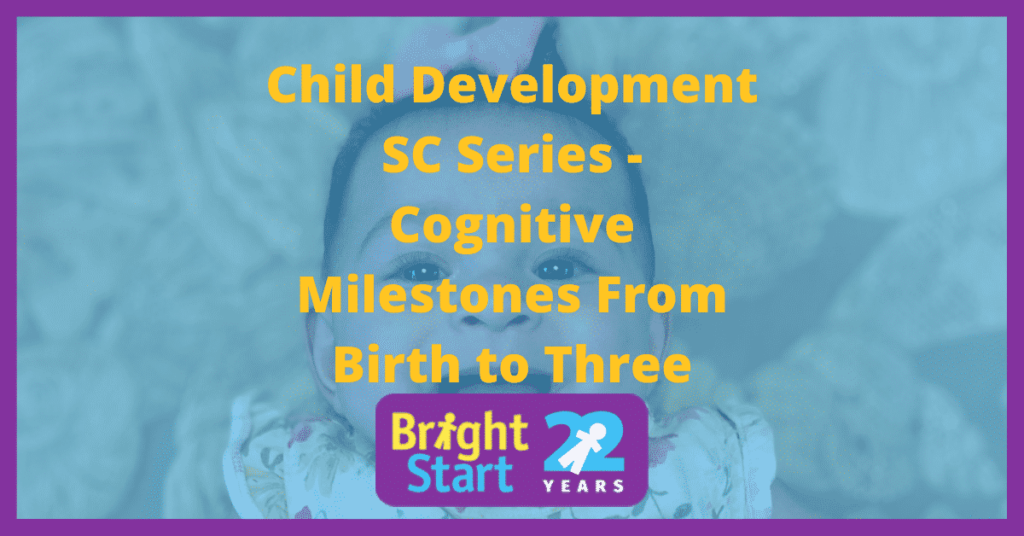
Cognitive Milestones from Birth to Age Three
Closely related to language acquisition and social-emotional development, cognitive milestones are some of the most well-known and anticipated in your child’s development. All of their congruent motor, language, social-cognitive, and self help developments work together to facilitate this cognitive development, helping your child interact with both new and familiar objects, people, and experiences. From birth on, talking to and engaging with your baby helps with development. This article will detail how cognitive development will look from birth to age three so you can better understand and support your child’s cognitive maturation.
Imitation and Repetition
From birth to two months, your baby will begin to pay attention to faces and will follow objects with their eyes. Alongside this recognition, your baby will more easily distinguish between black and white. Actions in the first two months of life will primarily focus on their own bodies, like staring at their fingers. It isn’t until the next few months that your baby will focus intensely on interactions with objects. In the first two months, babies will respond to sounds and even might find a few interesting. You’ll find that your baby experiences something like boredom and gets fussy without varied stimulus or attention.
By four months, your baby will respond to affection and recognize familiar people, aided by improved perception of color, increased depth of vision, and the ability to follow movement and activity with their eyes, including from side to side. Your baby will focus more on objects, reaching for toys with one hand and using their eyes and hands together. At six months your baby will understand cause and effect, leading them to experiment and repeat the actions that get interesting reactions. They might shake a rattle and laugh at the sound, then transfer the rattle back and forth from one hand to the other, using both hands to hold toys. They’ll also develop object permanence, or the understanding that things exist even when out of sight. Be careful with small objects and keep toys clean, because your baby will now try and put things in their mouth.
Experimentation Through Play
Nine months means your baby may get separation anxiety when leaving you, but with playful practice, they’ll learn to wave goodbye. This is a good time to play interactive games like peek-a-boo to inspire and develop communication. Your baby will respond to their name and simple commands, including “no.” This is an ideal time to talk and engage with your baby, considering they’ll be copying lots of the sounds you make. Your baby will also pick up their cereal with their thumb and forefinger, only further differentiating the various uses of their hands as they begin to exhibit more goal-oriented behavior. At twelve months, this experimentation will lead to banging things together, filling and emptying containers, poking with their pointer finger, brushing a doll’s hair, pushing a toy car, and holding a phone to their ear. All that copying of sounds will turn into “talking” on the phone as they continue to imitate your sounds. You’ll notice that your child, now officially a toddler, is imitating and repeating so much of what you do as they play and communicate with caregivers and family. At eighteen months, they’ll point to get attention from others and follow single-step commands, like pointing to a body part. In preparation for the increased independence to come at two years, they’ll show interest in scribbling with a crayon or playing pretend with a doll or animal.
At two years, your toddler will remember more words. It’s important to read to your toddler, as they’ll enjoy finishing rhymes or sentences in a favorite book and naming familiar pictures you point to, like those of a cat, dog, or car. Colored building blocks are also wonderful to introduce, as your child will begin to sort shapes and colors while building. They’ll also follow two-step directions, so you might help direct their play with simple and fun suggestions. By twenty-seven months your child’s ability to follow directions will progress into solving simple problems. They’ll laugh at silly things, like pictures in books. Your toddler’s ability to name pictures of things, like animals, will only improve. They’ll play pretend with others now, which makes this an ideal time for playdates. The increased attention span children display at thirty months, along with referring to themselves as “I,” and the ability to state their first and last name, will only accelerate the need for social activities with other children. Your child will now understand simple, cognitive concepts, like the difference between “big” and “small,” “hot” and “cold,” and “up” and “down.” They might enjoy using creative movement to express these concepts, like standing tall for “big” and crouching down for “small.”
Logic and Social Play
Play will only become more social and imaginative as your child reaches thirty-three months. They might develop an imaginary friend or pretend to be an animal. They’ll make one object stand-in for another, like pretending that a box is a house. As they begin to follow simple rules, they’ll ask “why” all the time, placing you firmly in the infamous “why” stage. This means they’re thinking logically. They’ll also progress as little mathematicians, learning to count to three. By three years your child will demonstrate the skills that will prepare them for school, like following two-step commands, copying a circle, turning pages of a book one at a time, understanding the concept of “two,” using a door handle, and knowing most of the parts of the body. These milestones coincide with self help development, as they tie their own shoes and zip up their jackets, fully potty trained and prepared for the independence of preschool. Cognitively, they’re ready for the independence of school, completing puzzles with three to four pieces independently and playing make-believe with dolls and animals. Their social maturation will also ensure that they’re prepared to use their developing cognition in collaborative play with classmates during extended periods away from you, with new friends and teachers.
For Further Information
As you can see, the different types of development we’ve covered across several blog posts are all related to one another. That’s why it’s so important to address the whole child when working with an early intervention team. You might have noticed how closely cognitive development is related to motor skills, or how important language and vocalization are in both social relationships and understanding cause and effect. For more information on how we treat the whole child, you can refer to “Key Benefits of Early Intervention for Special Needs,” or watch our informational videos filmed by our case managers and early interventionists in our blog. For a full chart of milestones, refer to “Baby and Child Development Milestones for South Carolina Parents,” available here.
